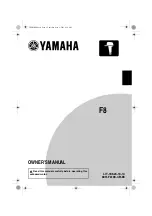
Evaluation Board User Guide
UG-189
Rev. 0 | Page 3 of 12
USING THE EVALUATION BOARD
The
ADP2302
/
ADP2303
evaluation boards are fully assembled
and tested. Before applying power to the evaluation board, follow
the procedures in this section.
JUMPER J5 (ENABLE)
Jumper J5 enables/disables the ADP2302/ADP2303. Set J5 to
EN HIGH to enable the device, and set J5 to EN LOW to
disable the device.
JUMPER J8 (PGOOD)
Jumper J8 connects/disconnects the power-good signal to VIN.
To pull the power good (PGOOD) pin up, connect J8 to the
input voltage through a 100 kΩ resistor. Disconnect J8 to leave
PGOOD open.
INPUT POWER SOURCE
If the input power source includes a current meter, use that
meter to monitor the input current. Connect the positive
terminal of the power source to J2 (VIN) on the evaluation
board and the negative terminal of the power source to J4
(GND) of the evaluation board.
If the power source does not include a current meter, connect a
current meter in series with the input source voltage. Connect
the positive lead (+) of the power source to the positive (+)
ammeter terminal, the negative lead (−) of the power source to
J4 (GND), and the negative lead (−) of the ammeter to J2 (VIN).
OUTPUT LOAD
Make sure that the board is turned off before connecting the load.
Connect an electronic load or resistor to set the load current. If
the load includes an ammeter, or if the current is not measured,
connect the load directly to the evaluation board, with the positive
(+) load connection to J1 (VOUT) and the negative (−) load
connection to J3 (GND).
If an ammeter is used, connect it in series with the load.
Connect the positive (+) ammeter terminal to J1 (VOUT), the
negative (−) ammeter terminal to the positive (+) load terminal,
and the negative (−) load terminal to J3 (GND).
INPUT AND OUTPUT VOLTMETER
Measure the input and output voltages with voltmeters. Make
sure that the voltmeters are connected to the appropriate evaluation
board terminals and not to the load or power source. If the
voltmeters are not connected directly to the evaluation board,
the measured voltages are incorrect due to the voltage drop
across the leads and/or connections between the evaluation
board, the power source, and/or the load.
To measure the input voltage, connect the positive terminal of
the voltmeter to J2 (VIN) and the negative terminal to J4 (GND).
Likewise, to measure the output voltage, connect the positive
terminal of the voltmeter to J1 (VOUT) and the negative
terminal to J3 (GND).
TURNING ON THE EVALUATION BOARD
Once the power source and load are connected to the evaluation
board, it can be powered for operation.
Perform the following steps:
1.
Ensure that the power source voltage is >V
OUT
+ 2.1 V
and <20 V.
2.
Ensure that J5 (EN) is high and monitor the output voltage.
If the load is not already enabled, enable the load, check that the
load is drawing the proper current, and verify that the output
voltage maintains voltage regulation.
MEASURING EVALUATION BOARD PERFORMANCE
Measuring the Switching Waveform
To observe the switching waveform with an oscilloscope,
place the oscilloscope probe tip at Test Point J7 (SW) with the
probe ground at GND. Set the scope to dc with the appropriate
voltage and time divisions. The switching waveform should
alternate between 0 V and approximate the input voltage.
Measuring Load Regulation
Load regulation should be tested by increasing the load at the
output and by observing the change in output voltage. To
minimize voltage drop, it is recommended to use short low
resistance wires.
Measuring Line Regulation
Vary the input voltage and examine the change in the output
voltage at a fixed output current.
Measuring Efficiency
The efficiency, η, is measured by comparing the input power
with the output power.
IN
IN
OUT
OUT
I
V
I
V
η
×
×
=
Measure the input and output voltages as close as possible to the
input and output capacitors to reduce the effect of voltage drop.
Measuring Inductor Current
The inductor current can be measured by removing one end of
the inductor from its pad and connecting a current loop in
series. A current probe can be connected to this wire.






























